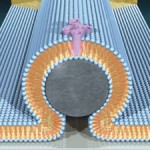Introducing the New ‘Leaf’
Posted on June 15, 2010
Filed Under Technology | Leave a Comment
We’ve been noting the advent of electric cars. Now here’s a review of one of them, the Nissan Leaf, that, along with the Chevy Volt, is likely to make 2010/11 a landmark time for battery-powered transportation. Both cars are aimed a the mass-market buyers. (One thing we seldom see, however, is discussion of the cost of replacing an electric car’s battery once it wears out. “Buy ’em new,” seems to be the best approach to electric autos.)
 Car magazine reports that Nissan purposely designed the Leaf to look “normal,” and so it does. It’s for urban and suburban use, not speedways, but can hit 90 mph. It has a range of around 100 miles.
Car magazine reports that Nissan purposely designed the Leaf to look “normal,” and so it does. It’s for urban and suburban use, not speedways, but can hit 90 mph. It has a range of around 100 miles.
We love this aspect of the car: It’s quieter than a Rolls Phantom. Up to 15 mph, it has “a muted jet engine whirr,” that’s discernable only to pedestrians – to warn them it’s around.
Here’s more on electric cars from Energy Biz Insider. – Doug Bedell
Machines Becoming Minute Cell Matter
Posted on June 10, 2010
Filed Under Technology | Leave a Comment
Practical uses are still years away, but we’re pleased to note that researchers have found a way to link technology with human cells very closely.
A nano-sized transistor is embedded in a cell-like membrane – “the most intimate binding of man and machine yet achieved.”
 “This device is as close to the seamless marriage of biological and electronic structures as anything else that people did before,” says Aleksandr Noy, a scientist at the University of California. The device is an implanted circuit, beginning with a simple transistor. But instead of using silicon, the most common material in transistors, the researchers “used a next generation material known as a carbon nanotube, a tiny straw-shaped material made from a single curved layer of carbon atoms arranged like the panels of a soccer ball.
“This device is as close to the seamless marriage of biological and electronic structures as anything else that people did before,” says Aleksandr Noy, a scientist at the University of California. The device is an implanted circuit, beginning with a simple transistor. But instead of using silicon, the most common material in transistors, the researchers “used a next generation material known as a carbon nanotube, a tiny straw-shaped material made from a single curved layer of carbon atoms arranged like the panels of a soccer ball.
“The scientists then coated the carbon nanotube transistor with a lipid bilayer, basically a double wall of oil molecules that cells use to separate their insides from their environment.” They did’t use an actual cell membrane, however…
There’s more on the technique in the online article in Discovery News. The bottom line is it may one day be possible to gather information “about the inner workings of disease-related proteins inside the cell membrane, and eventually lead to new ways to read, and even influence, brain or nerve cells.”
This kind of research holds promise for people with bodily ailments, though “any actual treatment is still years away.” Wouldn’t it be great if something like this could be used to restart, say, damaged spinal cells and restore motion in inert muscles?
Whatever eventually results from work like this, the point is that technical ingenuity is being combined in the most intimate way imanginable with building-block bodily structures. Mind and matter are on their way, in given applications at least, to becoming one. – Doug Bedell
– The illustration is an artist’s representation of a new transistor that’s contained within a cell-like membrane. In the core of the device is a silicon nanowire (grey), covered with a lipid bilayer (blue).
Learning from Adversity Should Occur Widely
Posted on June 3, 2010
Filed Under Technology | Leave a Comment
The technological disaster of our time is now the BP oil spill, not the Three Mile Island nuclear power accident 31 years ago or the Challenger rocket explosion in 1986. BP is a real disaster, while TMI (which we’re most familiar with) was only a perceived one. A mere $1 billion was spent cleaning up TMI Unit 2 after the uranium fuel in its reactor vessel partially melted. The damage at TMI-2 was confined to the reactor system and its containment building.
Both of us, Dennis Owen and Doug Bedell, worked at TMI during the Unit 2 cleanup and the restart of TMI-1. Dennis was a recovery engineer at Unit 2 and Doug was TMI’s post-accident communication manager.
The TMI accident effectively shut down construction of new U.S. nuclear plants for 30 years. Plants under construction were allowed to continue, and retrofits were ordered at operating plants once the “stuck-open-valve” malfunction was understood. Similarly, offshore oil rigs now operating should be closely monitored and possibly retrofitted when the problem at BP’s well is understood.
As turned out to be the case at TMI, cultural issues having to do with training and attentiveness – by employees and management alike – are likely at the heart of the BP disaster or, indeed, catastrophe. Why do we keep having to learn such things anew, at such cost?
Whether it was arrogance or ineptitude, not enough attention was paid to operational issues at BP’s oil platform. Newsweek is already making that clear in a gripping article, “Black Water Rising,” in its June 7 issue. A presidential commission will be investigating the accident, like the Kemeny Commission did after the accident at TMI-2.
When the Kemeny report came out, industry generally should have paid enough attention to its findings to avoid another costly accident, anywhere.
The now defunct General Public Utilities Corp., TMI’s owner at the time, was determined to learn all that it could from the Unit 2 accident, very much to its credit. Focusing on the lessons of the accident improved GPU’s corporate culture overall, and a strong, knowledge-imparting culture is essential to avoiding accidents. (Making wrong guesses about the direction of energy prices is perhaps another matter.)
The worst kind of situation at any company is to have the sort of “good ol’ boys” culture that Newsweek describes as having existed at BP and the Interior Department’s Minerals Management Service (MMS). “Oil guys know best” is nothing like having actual awareness of what can go wrong and how.
At TMI-2, the operators were misled early one morning by inadequate signaling on their control panels. They mistook a stuck open valve for an indication that the reactor’s cooling system had too much water when actually it was losing water. Better training as well as a redesigned control room were part of the answer then. But the biggest “gain” from that situation was the simple awareness that unexpected events can happen – to try to avoid them, but to be responsibly ready for them if they occur.
That, and to have effective regulation as well. In nuclear power, the Nuclear Regulatory Commission and its inspectors at the plants keep their distance from the industry, as the MMS folks apparently did not.
After the latest BP accident, President Obama asked Energy Secretary Steven Chu, a Nobel Laureate himself, “to assemble the best minds in America and get them down there.” Some of the best minds in America were assembled for John Kemeny’s commission on TMI-2. The problem is how we learn, and how widely we learn, from disastrous events and the findings they inevitably produce. This applies not only to operational managements but professional and trade societies as well.
NASA likely has the lessons of the Challenger accident seared in its institutional memory, as TMI’s staff and the Nuclear Regulatory Commission no doubt readily recall the Unit 2 accident. Learning from disasters, however, has to occur in a lot wider manner than among those directly involved. Suppose BP had paid attention, close attention, to the Challenger, TMI and, indeed, the Exxon Valdez oil spill. We don’t know whether they did or not, but if they did, it hasn’t been showing. – Doug Bedell
Kevin Costner’s Moxie in the Gulf
Posted on May 26, 2010
Filed Under Business, Technology | Leave a Comment
Another blog got to this first, but if you’re Kevin Costner with a good idea, we have to agree, Field of Dreams-like, “He built it, so let him come.”
In this instance, we’re referring to Costner’s centrifugal oil separation machines, which are being checked out by BP in the Gulf of Mexico. They’ve been developed by Costner’s company, with $24 million of his own money and the wonderfully appropriate name of Ocean Therapy Solutions.
 A great technical tale appears to be unfolding here, powered by a visionary sense of environmental utility that was triggered by the Exxon Valdez spill in 1989. Kostner was ticked off about that, big time. So, as The New York Times’ Green blog reports, he bought the emerging centrifugal technology from the government and invested heavily in getting it ready for another big spill.
A great technical tale appears to be unfolding here, powered by a visionary sense of environmental utility that was triggered by the Exxon Valdez spill in 1989. Kostner was ticked off about that, big time. So, as The New York Times’ Green blog reports, he bought the emerging centrifugal technology from the government and invested heavily in getting it ready for another big spill.
Perhaps providentially for Costner, along came BP’s gulf spill. The oil giant has approved six of Ocean Therapy’s 32 machines for testing. They’re supposed to, says The New York Times, “suck oil from water, separate the oil, store it in a tanker and send the water, 99.9 percent purified, back into the gulf.”
Costner is confident they’ll do just that. “I’m very happy the light of day has come to this,” he said at a news conference in New Orleans, explaining he was “very sad” about the spill “but this is why it’s developed (the centrifugal technology).” Costner’s barrel-like machines will be mounted on barges and trundled out to spin oil from water. Details of any contractual relationship between BP and Costner, should the machines indeed work, have not be disclosed, The Los Angeles Times reports.
This is the way it is with technology – an idea and the vision to extend it, the ingenuity to perfect it, and the commitment of resources, personal or borrowed, to prove it out. All those images of “Waterworld,” “Field of Dreams” and other Costner films that flickered on so many movie screens around the world may now be contributing to a happier reality than would have been likely without Costner’s moxie, providing he’s proven out, which many people along the gulf are hoping for.
Right on, Kevin! – Doug Bedell
Tesla and Toyota Acting Smartly Together
Posted on May 20, 2010
Filed Under Technology | Leave a Comment
Here’s an exciting story of two carmakers collaborating for mutual advantage and serving U.S. energy goals in the bargain. Toyota and Tesla Motors are parterning to reopen the former General Motors/Toyota NUMMI plant at Fremont, CA, to build electric cars there – and potentially recall thousands of laid-off workers.
Tesla Motors, advises Wikipedia, “is a Silicon Valley-based company that engages in the design, manufacture, and sale of electric vehicles (EVs) and electric vehicle power train components. It is currently the only automaker building and selling highway-capable EVs in serial production (as opposed to prototype or evaluation fleet production) in North America or Europe.” It produces at least 15, mostly custom-ordered cars a week.
Here’s the essence of the Tesla-Toyota deal, as reported on the GreenBeat blog:
“1. The joint development of a brand new,sub- $30,000 electric car, that will contain Tesla’s unique powertrain design, with everything else built by Toyota;
“2. The purchase of the NUMMI plant, where Tesla plans to manufacture both its Model S sedan due out in 2012, a new $30,000 Tesla-designed vehicle, and the more affordable jointly designed “third-generation” vehicle;
“3. A $50 million investment from Toyota into Tesla when the company goes public, probably later this year.”
 Another electric car initiative in the U.S. will enliven the marketing scene that’s been developing around the forthcoming Chevy Volt and Nissan Leaf. 4,700 people worked at the NUMMI plant and it’s possible that when Tesla’s Toyota-assisted sub-$30,000 car rolls out even more than that number will be employed.
Another electric car initiative in the U.S. will enliven the marketing scene that’s been developing around the forthcoming Chevy Volt and Nissan Leaf. 4,700 people worked at the NUMMI plant and it’s possible that when Tesla’s Toyota-assisted sub-$30,000 car rolls out even more than that number will be employed.
This is all great news involving intelligent energy policy and enlightened management thinking as well. A win-win partnership very much in the public interest. – Doug Bedell
* * *
This is a significant development. I lived only about 10 miles away from that plant and it was a big employer when I was young. I recall touring the plant with my Boy Scout troop.
I understand Tesla’s existing models sell from about $50,000 to $100,000, so a sub-$30,000 vehicle is a big step forward. I’ve read reviews of their existing models and they have amazing acceleration.
This is a nice example of a Silicon Valley startup thinking outside the box and coming up with a way to ramp up production quickly. – Dennis Owen
Candidates for Summer Reading
Posted on May 16, 2010
Filed Under Technology | Leave a Comment
We’re not great fans of lists (though we sometimes get curious about what made a given list and what didn’t). But here’s one that anticipates a prime seasonal activity: Summer reading.
 Two gents who write for the V3.co.uk blog, Iain Thompson and Shaun Nichols, have compiled a list of the “Top 10 science fiction writers.” “We’re going to get hammered on this one,” they note right off. And they’re getting lots of comments, some critical of their choices and others supportive.
Two gents who write for the V3.co.uk blog, Iain Thompson and Shaun Nichols, have compiled a list of the “Top 10 science fiction writers.” “We’re going to get hammered on this one,” they note right off. And they’re getting lots of comments, some critical of their choices and others supportive.
In the interest of providing summer reading possibilities, some of which you may have forgotten about, here’s their 10 science fiction icons. They include explanations of their choices, which gives the list more heft then on than one simply plucked from the blue:
1. Arthur C. Clarke – “The most popular question asked by SF authors is ‘What makes us human?’, a query that Clarke regularly made with his most popular works,” including, of course, 2001: A Space Odyssey.
2. Jules Verne – “Verne’s writings predicted a host of inventions, including everything from air conditioning to helicopters….Some of his writing was also prescient. One story involved three astronauts launched from southern Florida in a capsule that splashes back to Earth.”
3. Douglas Adams – “Adams thrived because he mixed a great sense of humour into his work. Starting as a television writer and making a brief appearance on Monty Python’s Flying Circus, Adams was later employed to write a radio series for the BBC. What followed was one of the most beloved works of SF in the past half centure…The Hitchhiker’s Guide to the Galaxy.”
4. Isaac Asimov – “Asimov wrote some great SF to be sure. The Robot stories were light years ahead of their time in terms of understanding the thinking behind artificial intelligence (AI) programming and the consequences of getting it wrong.”
5. Harlan Ellison – “His dark, edgy works helped pave the way for contemporary SF styles such as cyberpunk, and helped the genre mature and adapt to changing attitudes.”
6. Robert Heinlein – “In addition to excellent stories, Heinlein contributed the idea that you can make a poignant social and political commentary while still telling a great story.”
7. Neal Stephenson – “While Stephenson’s earlier work, particularly Zodiac, is more scientific than technical he hit his SF form with Snow Crash and followed through in 1995 with Diamond Age, a brilliant examination of nanotechnology and the way society, commerce and computing systems will be changed by new technology.”
8. William Gibson – “Barely a year after IBM introduced its first PC, Gibson described the future of online communications and the story potential of artificial intelligence in such an environment. It was a mental leap that left the rest of the SF world scrambling to catch up. Gibson’s style and subject unleashed a whole new form of SF onto the market in the form of ‘cyberpunk’.”
9. H. G. Wells – “Works such as The Time Machine, The Invisible Man and The War of the Worlds, which dealt with the fields of physics, chemistry and biology respectively, are still watched and reworked today, with varying degrees of success.”
10. Iain M. Banks – “Most of his SF output takes place in the Culture universe, a polyglot society of roughly humanoid ancestry tens of thousands of years ahead of today. It’s a society where computer and human minds meld, where technology comes close to magic and yet the same old human (and alien) concerns come to the fore.”
And two Honorable Mentions: Gene Roddenberry (author of the original Star Trek series) and Charles Stross (Glasshouse).
Be sure not to forget the sun tan lotion. – Doug Bedell
Information Isn’t Knowledge, and We’re Drowning In It
Posted on May 9, 2010
Filed Under Business, Technology | Leave a Comment
Phil Murray argues in a meaty article in KM World that we’re paying too much attention to information, trying too hard to cope with its rising tides, and not enough to meaning. He’s got a point, a truly profound one, actually.
 We’re preoccupied, for instance, with all the coverage of possible damage from the BP oil spill, and not giving enough attention, at least not yet, to whether it’s smart to drill in 5,000 feet of water in the first place. We’ve had the information that it can be done, but is it wise to do it? What’s the current meaning of our energy situation, anyway? In what context are we looking at that?
We’re preoccupied, for instance, with all the coverage of possible damage from the BP oil spill, and not giving enough attention, at least not yet, to whether it’s smart to drill in 5,000 feet of water in the first place. We’ve had the information that it can be done, but is it wise to do it? What’s the current meaning of our energy situation, anyway? In what context are we looking at that?
“Meaning? Yes, ‘the thing one intends to convey especially by language,’ according to the Merriam Webster dictionary,” Murray writes. “…The connections among things. Causes and effects. In the context of work: the relevance or importance of those connections. The subject of logic, argument and epistemology. A pervasive, essential aspect of rational human activities that is accepted as critical to creation of value and economic progress, and yet an idea routinely dismissed as unusable, elusive and unmanageable at the same time…” So keep piling up the information, without asking whether it’s really worth the risk of an explosive gas bubble surging up from the ocean floor.
Knowledge is information refined by a disciplined approach to reality exercised on a different plane than those of incoming flows or profit projections.
These sorts of things ought to be concerns for knowledge workers everywhere, Murray (whose article went to press a couple of months before the BP spill) rightly insists.
“The stunning reality is that we, as knowledge workers, often spend more than half our time doing work that has no formal description, no standards for best practices and no appropriate metrics. What’s more, that work is not formally or explicity connected to specific outcomes, whether they are services or products.”
So let’s try hard to get focused on relationships and meaning, along with information. That’s where the real value in knowledge work (I almost slipped and said “intellectual work” ) lies.
Murray’s lengthy piece is one to ponder and pass along, seriously. – Doug Bedell
Illustration courtesy of freedigitalphotos.net.
Technology Tracking Us Down
Posted on April 29, 2010
Filed Under Technology | Leave a Comment
It’s getting so that technology can follow you anywhere, sometimes with adverse consequences for the follower.
The Lower Merion School District outside Philadelphia, one of Pennsylvania’s, if not the nation’s, finest school districts, is in expensive legal trouble for using LANrev asset-tracking software surreptitiously in hopes of turning up missing school-issued laptop computers. When activated by district personnel, the software took 56,000 or more photos of students in their homes and bedrooms from the webcams on their laptops, unknown to the kids themselves or their parents. When the district allegedly stonewalled on what its IT people were doing, a couple of parents filed a lawsuit that’s likely to cost the Lower Merion schools a bundle.
Ireland’s Aer Lingus airline isn’t monitoring passengers any more than they’re being scrutinized by security people these days, but it’s turning their seats into onboard, online shopping malls. A news release from GuestLogix, Inc., says that, with a multi-year Aer Lingus deal, it’s now providing its onboard credit-card-propelled shopping service to “35 percent of global airline passenger traffic.”
There you are, high above the clouds, and the urge strikes to buy a new pair of cufflinks. No problem; a sales device is at hand. (We thought on a recent flight we were asked to keep cell phones and other such electronic equipment turned off, but maybe that was just on takeoff and landing.)
We’re wondering if we’ll come to a point at which society will say, in some manner, “Just because we can do it, doesn’t mean we will do it. That sort of thinking might make some technologist friends jittery, but some of the devices they’re coming up with are making us a little queasy. – Doug Bedell
An Underwater Robot Powered by Temperature Differences
Posted on April 20, 2010
Filed Under Technology | Leave a Comment
We wrote a while back about industrial robots that are gaining amazing dexterity in their arms and fingers. Now here’s word of robotic vehicles that can roam underwater powered entirely by the natural temperature differences at different ocean depths.
Couple mobile underwater robots with reach and grasp and you have new exploratory possibilities for sure.
NASA, the U.S. Navy and university researchers have demonstrated “the first robotic underwater vehicle to be powered entirely by the natural temperature differences found in varying depths of the ocean.”
 The new technology is functioning on an undersea robot called the Sounding Oceanographic Lagrangrian Observer Thermal RECharging (SOLO-TREC). It’s envisioned to be useful for indefinite monitoring of the oceans for climate and marine animal studies as well as exploration and, of course, surveillance. (James Bond, get back into your wet suit!)
The new technology is functioning on an undersea robot called the Sounding Oceanographic Lagrangrian Observer Thermal RECharging (SOLO-TREC). It’s envisioned to be useful for indefinite monitoring of the oceans for climate and marine animal studies as well as exploration and, of course, surveillance. (James Bond, get back into your wet suit!)
SOLO-TREC, in fact, sounds like the fabled perpetual motion machine, but it really isn’t that. “People have long dreamed of a machine that produces more energy than it consumes and runs indefinitely,” Jack Jones, a NASA Jet Propulsion Laboratory (JPL) principal engineer in Pasadena, Calif. and SOLO-TREC co-principal investigator, said in a statement.
“While not a true perpetual motion machine, since we actually consume some environmental energy, the prototype system demonstrated by JPL and its partners can continuously monitor the ocean without a limit on its lifetime imposed by energy supply,” Jones said.
SOLO-TREC was recently tested for three months 100 miles southwest of Honolulu, Hawaii. It’s a technological wonder that promises to give us far-ranging access to the oceans. – Doug Bedell
Miniaturization at the ‘Indy 500’
Posted on April 2, 2010
Filed Under Technology | Leave a Comment
Two months and it will be “Indy 500” time again. That’s a day for celebrating not only driving skill and sportsmanship but also high technology.
And not just all that goes into the high-speed Indy cars themselves. Here, for instance, is an example of miniaturization that’s likely to get the the ear of an Indy car driver – get into the ear of an Indy driver, that is.
 IndyCar Driver Earpieces don’t just protect a driver’s ears from the piercing roar of the cars. They contain speakers that allow the driver to communicate with his pit crew. And they include “multi-axis accelerometers” for accumulating information that, in the event of a wreck, can help determine the impact forces the driver endured.
IndyCar Driver Earpieces don’t just protect a driver’s ears from the piercing roar of the cars. They contain speakers that allow the driver to communicate with his pit crew. And they include “multi-axis accelerometers” for accumulating information that, in the event of a wreck, can help determine the impact forces the driver endured.
All that at the end of a cable that goes into your ear (if you’re an Indy car driver). There may be even more impressive examples of miniaturization, but these Indy earpieces are surely examples of technological ingenuity at its best.
To get you in the mood for this year’s Memorial Day “500”, here’s a video of the “closest Indy car race ever,” not from the Indianapolis speedway, as it happened but from the Chicagoland speedway in 2003. – Doug Bedell
« go back — keep looking »Recently
- Presentations With Forethought
- Technical Writing’s Lineage – Surely It’s Deeper than Digital
- At the Holidays, Twitting Amazon
- Successful Cookie Baking – From Mom, an Acknowledged Expert
- Slides for a Tech Writer’s Craft
- Digital or Not, Be Clear
- Being Watchful About Digital Designs…
- When Proposals Don’t Click, Keep Making Them Anyway
- Like a Good Gardener, Help an Enterprise Keep Itself Current
- We’re Leaders All, And Need to Think That Way
Categories
Archives
- January 2017
- December 2016
- November 2016
- October 2016
- September 2016
- August 2016
- July 2016
- June 2016
- May 2016
- April 2016
- March 2016
- February 2016
- January 2016
- December 2015
- November 2015
- October 2015
- September 2015
- August 2015
- July 2015
- June 2015
- May 2015
- April 2015
- March 2015
- February 2015
- January 2015
- December 2014
- November 2014
- October 2014
- March 2014
- February 2014
- January 2014
- December 2013
- November 2013
- October 2013
- September 2013
- August 2013
- July 2013
- June 2013
- May 2013
- April 2013
- March 2013
- February 2013
- January 2013
- December 2012
- November 2012
- October 2012
- September 2012
- August 2012
- July 2012
- June 2012
- May 2012
- April 2012
- March 2012
- February 2012
- January 2012
- December 2011
- November 2011
- October 2011
- September 2011
- August 2011
- July 2011
- June 2011
- May 2011
- April 2011
- March 2011
- February 2011
- January 2011
- December 2010
- November 2010
- October 2010
- September 2010
- August 2010
- July 2010
- June 2010
- May 2010
- April 2010
- March 2010
- February 2010
- January 2010